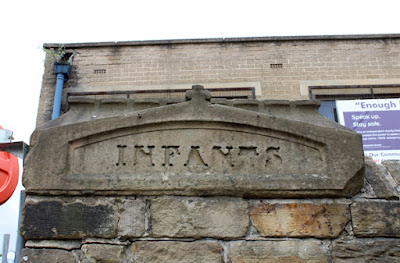 |
| A weathered inscribed pier cap |
Walking up Sharrow Lane, having had a look at some of the historic buildings on London Road, I had a quick wander round the grounds of the former Mount Pleasant Community Centre, where I noticed the former Highfield Special Council School.
With the Sitwell Road entrance being locked and not seeing any other entrance to the building, which is currently disused and boarded up, I didn’t investigate further on this occasion and carried on up Sharrow Lane until I reached the former Sharrow Lane Board School.
Built in 1887 to a design by CJ Innocent, who now worked on his own following the death of his partner Thomas Brown, the school was originally for senior children but was subsequently extended in 1890 and 1894, with separate departments for juniors and infants bringing the total number of places to over 1000.
Compared to his earlier designs, with Innocent and Brown, it is very simple and restrained in style, with none of his earlier ‘trademark’ features being employed here, except for a covered play area that survives intact.
Looking at all three phases of building, the walling stone is uniformly light buff colour, medium grained and has well defined bedding planes – as seen at Carbrook, Walkley, Heeley Bank and Darnall – and is assumed to be the Crawshaw Sandstone from the Bole Hills quarries in Crookes.
The same stone is used for voussoirs to the ground floor windows of the main block and arches to the infants’ school, although the dressings to the other openings are a massive sandstone that are presumably Stoke Hall stone – the gritty sandstone from the Kinderscout Grit in Grindleford, which is used widely in the board schools and other prestigious buildings in Sheffield.
The only place where there is any variation in the stonework is at one place on the Vincent Road elevation, where a small C20 extension has been built in a sandstone that is clearly different to the original stone and has probably been brought in from West Yorkshire. There is also the now familiar use of coarser stone, probably from the Millstone Grit Group, for the inscribed pier caps, but here this typically durable stone has not weathered well.







The stone is a nice mellow colour, but used in such thin blocks, rather spoils the effect with a "brick-y" texture
ReplyDelete